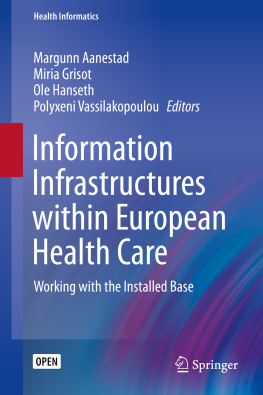1.1 Background and Aim of the Book
Confronting quality-of-care problems and achieving cost containment in healthcare delivery is one of the greatest challenges for the twenty-first century. Realising the promise of eHealth for ensuring sustainability of Europes healthcare systems is becoming urgent. When seen in a context of increasing needs for health personnel, growth in chronic disease, an ageing population and a consequential expected rise in public health expenditures, the successful utilisation of information and communication technologies becomes crucial. The eHealth Strategies Report prepared on behalf of the European Commission, Directorate General Information Society and Media, in 2011, points to implementation as a key challenge: Reaching agreement about eHealth strategies and, even more so, implementing them has almost everywhere proven to be considerable more complex and time-consuming than initially anticipated. The complexity of eHealth as a management challenge was vastly underestimated. (Stroetmann et al. ). If we want substantial advancements in healthcare information infrastructures, we need knowledge on actual experiences, and the contributions in this book aim to give the readers a better grip on what facilitates and hinders successful implementation and utilization.
Currently, European countries have reached a level of technological maturity where most healthcare organisations (both within hospitals and within primary care) have impressive systems to support their day to day operations (European Commission DG Communications Networks Content & Technology ). But, the systems tend not to talk to each other: if a patient has a blood test at a primary care outlet, then a treatment at a specialist hospital, and then an operation in a different hospital, it may take weeks for the electronic records to reflect comprehensively all encounters. Information flows that cross organisational boundaries are still a major issue for healthcare.
Within European healthcare, the problem that we now have to address is how to introduce new technological capabilities that link and leverage what is already in place, blending in the already densely populated health technology landscapes. In the extant literature on health informatics the relationship between novel systems and pre-existing infrastructural resources has been mostly addressed as an issue of connectivity or interoperability (from a technical point of view) or technology acceptance/appropriation (from an organizational point of view). Novelty is viewed as something distinct from what is already in place and the main concern is how the new and the old can be fitted together. In this book we propose an alternative way to understand and approach the challenges of implementation. The central theme here is how change initiatives encounter the pre-existing health technology landscape. The overall aim of the book is to provide insights on the role of existing elements as resources for new development, the conducts through which they contribute to the composition of novelty and the modes through which the pre-existing technological and institutional resources are mobilized, recombined, or obliterated. We explore this issue by analysing cases of inter-organizational information systems where a multitude of pre-existing infrastructural elements exist.
Specifically, the book includes a number of case studies on the design and implementation of systems that span organisational boundaries in different healthcare settings across Europe. The two types of systems covered are: e-prescription and governmental patient-oriented web platforms. The case descriptions go beyond the trajectories of design and development to include experiences of reworking and reconfiguration during and after deployment as this has proved to be pivotal for systems evolution. We have selected the two specific types of systems not only because they are widespread around Europe and allow comparisons but also because they are exemplary of two different types of grand aims. E-prescription initiatives are usually seen as opportunities to improve health care delivery by systematic and not dramatic change (controlling the ever-increasing medication costs, improving patient safety and providing rich information for performance management). Governmental patient-oriented web platforms are seen as opportunities to pursue wider and more radical innovation, aiming to strengthen the patients role and to facilitate a shift from provider-centred health care towards patient-centeredness.
The empirical material from the different cases is analysed through the information infrastructure perspective (Star and Ruhleder ).
The chapters of the book present rich empirical cases analysed through a specific theoretical lens. Therefore, we offer a book where theoretical insights and practical experiences are tightly connected. The contributions to the book are sourced from a network of academics that have been working on the topic for years, have previously collaborated and share a common understanding of the challenges entailed in expanding information infrastructures within health care.
The book aims to to respond to the needs of different audiences:
Academic researchers from different disciplines including: information systems research, health care management, innovation studies
Practitioners involved in the design and development of information systems within health care, policy makers and ordering organizations
Students in information systems, technology management and health care management programs.
1.2 Outline of the Book
The book is organized in three sections. In section A we present the empirical domain of the book, the context of eHealth infrastructures, the core theoretical concepts, and the cross-case analysis of the cases. This is followed by eleven chapters analysing various European experiences with putting in place eHealth infrastructures. Section B includes empirical chapters on e-prescription from Spain, Norway, Greece, the UK and Germany. Section C includes empirical chapters on governmental platforms for patient-oriented eHealth services from Spain, Norway, Denmark, Sweden and Italy.
1.2.1 Section A: Information Infrastructures in Healthcare
The first chapter in this section provides an introductory overview of the eHealth landscape, and then a more detailed discussion of e-prescription solutions and governmental patient-oriented web platforms and their drivers. E-prescription initiatives are driven by concerns to monitor and control prescriptions not only for ensuring healthcare quality but also for reasons of cost control. Patient platforms seek to realize visions of patient-centered care, but are also driven by needs to improve the efficiency of healthcare provision, such as overcoming existing communication barriers and mobilizing citizens towards self-care and proactive disease prevention. We argue that eHealth infrastructures have a dual character. They have a transformative orientation and are expected to instigate the reshaping of core roles and relationships within the healthcare systems. However, they also leverage and need to fit to, existing services, capabilities, institutions, data sources, systems, and communication channels.





